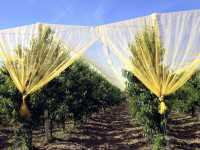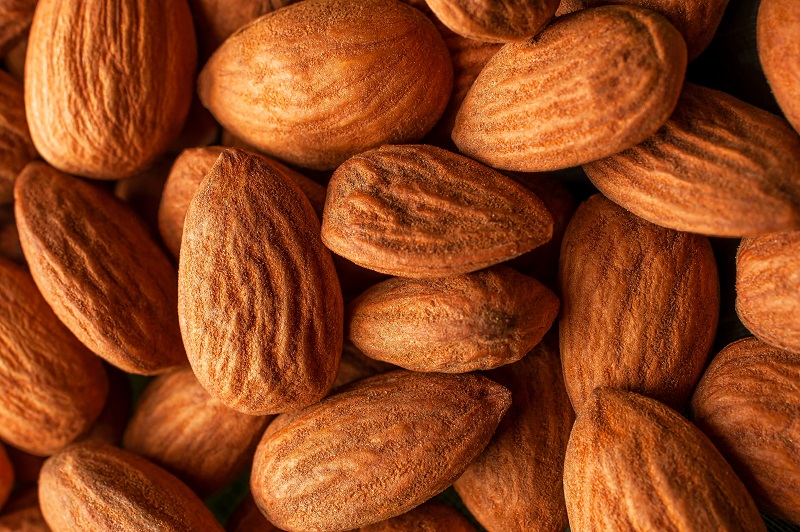Protecting Your Long-Term Investment In The Orchard

The modern high-density orchard represents a very significant long-term investment that faces many environmental perils. With as many as 2,000 trees per acre or more of patented cultivars growing on multi-wired trellises, such systems must generate a significant return on investment that begins early in the life of the orchard and that is sustained for at least 15 years. With some high-value cultivars like Honeycrisp fetching from $50 to $100 per packed box in the market, any fruit that are damaged and unmarketable can represent devastating losses to the grower. In contrast to the larger trees of older systems, these high-density systems have narrow canopies where fruit are more directly exposed to adverse weather and high sunlight conditions, which can result in losses from hail damage and sunburn.
In June 2013, I visited Italy for the International Society of Horticultural Science VIII International Peach Symposium. While there, I toured several high-density commercial orchards where overhead netting is being used both for protection from hail and to reduce sunburn. At one site we visited, the grower told me that the orchard had already been hailed on four times this season! The commercially available nets that are being evaluated by my Italian research colleagues include the industry standard traditional black netting but also colored nets including pearl, yellow, red, and blue. The colored nets transmit more sunlight (less shading) than the black nets and provide other benefits such as more uniform skin coloration and improved size. By filtering the sunlight, these colored nets can alter not just the quantity of light used in photosynthesis but also the quality of light used for other physiological processes. This light filtering can alter the orchard microclimate and reduce tree heat stress.
Hail netting is widely used in the major tree fruit production areas of Italy and South Africa, but only to a limited extent in the U.S. In areas where the risk of hail is significant, growers here often purchase hail insurance. In the case of apples, hail causes damage not only to this year’s fruit, leaves, and shoots, but also often wounds woody branches and spurs as well. Open wounds can provide entry points for insects or diseases such as fire blight to become established. The long-term impact of one serious hailstorm can be significant enough that it requires significant limb renovation. In worst-case scenarios, trees may need to be removed and replanted. Thus, protecting from just one hailstorm could justify the cost of the supporting infrastructure and nets themselves.
Alternatives Needed
With my recent move to Wenatchee, WA, where the local slogan of “300 days of sunshine” per year is lauded, I have become increasingly aware of sunburn as another very significant cause of fruit cullage at harvest. One widely used technique to reduce sunburn is the combined use of overhead sprinkling or misting (for evaporative cooling to reduce fruit skin temperature) combined with spray-on sunburn protectants like Raynox (carnauba wax plus organically modified clay). However, with the recent passage of the federal Food Safety Modernization Act and future regulations concerning the use of non-potable “agricultural water,” it remains unclear whether overhead sprinkling/misting for sunburn protection will be legally permissable in the future.
Dr. Stefano Musacchi, formerly of the University of Bologna, Italy, recently joined us at the Washington State University Tree Fruit Research and Extension Center here in Wenatchee as the new Endowed Chair in tree fruit physiology and management. In the past, he has conducted trials using colored hail nets in Italy.
In 2014, we plan to conduct several long-term commercial trials in Washington. We are eager to test these products under the high sunlight conditions in central Washington, especially for high-value apple cultivars that are sunburn sensitive. Besides the potential to eliminate hail risk and sunburn, if nets are allowed to come to the ground and enclose the orchard block, they also provide the potential to exclude damaging birds and insects. The nets have the potential to eliminate the need for overhead irrigation for sunburn control. If so, this may substantially reduce orchard water use requirements and periodic soil waterlogging. Further, this may reduce soil nutrient leaching, pesticide wash-off, and disease pressure (i.e., mildew, sphaeropsis rot, etc.) in the orchard. It has also been reported that UV light transmission through the nets can be substantially reduced. This may present worker safety benefits by reducing potential risk to conditions that can lead to skin cancer.
Whether growers buy hail insurance, invest in overhead cooling, use sunburn protectant products or nets, or a combination thereof, it costs money to mitigate potential losses. A thorough economic analysis based on experimental data from commercial trials is necessary to help determine how best to protect your investment.










